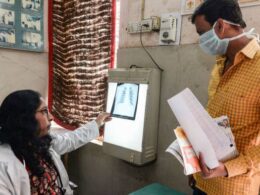This is a republication of the article below, with the title above, highligting the topic in question.
Health Leaders
Mandy Roth
OCTOBER 12, 2020
Edited by
Joaquim Cardoso MSc.
Health Management Transformation
Institute for Better Health, Care, and Cost, for All
June 20, 2022
The Unexpected Side Effect of COVID-19: Collaboration
Innovation executives share 5 ways their organizations are experiencing enhanced teamwork inside and outside their organizations. The unprecedented cooperation has accelerated advancements in care delivery.
KEY TAKEAWAYS
- The need to innovate quickly brought down the silos that often exist between hospital departments, particularly between innovation and IT.
- With a need to share resources, COVID-19 unified some health systems, which began operating as a single entity, rather than separate hospitals.
- The pandemic made friends of foes as competing hospitals and health systems engaged in deep collaborations to better serve their patients and communities.
Structure of the publication
- 1. Departmental silos tumbled down
- 2. Focus shifted to support frontline colleagues
- 3. Health systems acted as single organizations, rather than separate hospitals
- 4. Competitors became collaborators
- 5. Community organizations participated in data-sharing initiatives
With the arrival of COVID-19 came chaos. And from that chaos rose innovations that have transformed healthcare delivery. Yet, according to healthcare executives, during the interim between the arrival of the pandemic and the innovations that followed, a remarkable phenomenon occurred: unprecedented collaboration.
Walls between siloed departments within hospitals tumbled down. Representatives from competing hospitals met to share information. Community organizations and public health departments exchanged data with health systems. Physicians, whose offices had closed, shared their personal protective equipment (PPE) with colleagues on the front line of the battle.
“In many ways, COVID deconstructed a lot of the bureaucracy that was standing in the way of innovation,” says Jayne Morgan, MD, a cardiologist and director of innovation at Piedmont Healthcare in Atlanta, Georgia. Morgan was among the innovation executives who participated in roundtable discussions during the virtual HealthLeaders Innovation Exchange this summer to share experiences and ideas with other hospital and health system colleagues.
One of the themes to emerge from that discussion was the value of collaboration in the innovation process and the many forms it has taken. Following are five ways collaboration has helped change the healthcare landscape during the COVID-19 pandemic, along with the advantages this type of cooperation provides to the industry.
1. Departmental Silos Tumbled Down
The innovation arm of a health system must work with multiple departments to bring its initiatives to life. Yet multiple competing priorities and the propensity to work in silos can inhibit progress. COVID-19 changed those dynamics.
Pothik Chatterjee, MBA, MA, executive director, innovation and research at LifeBridge Health, a five-hospital system based in Baltimore, Maryland, explains how the role of his department morphed during the pandemic. “I think two things have changed,” he says. “One is the breakdown of silos that previously existed between innovation, finance, supply chain, and IT. Those came down very quickly because of the urgency of the pandemic.”
He continues, “The second thing that is fundamentally different is the perception of innovation departments and why they exist. Pre-COVID, some viewed innovation as complementary to information systems to help with digital health implementation. But with COVID, there was a real need to have almost an internal consulting group that could be used for urgent questions, whether it’s N95 masks and decontamination, or 3D printing of face shields, for example. Many of those questions came to [our innovation department],” he says. “I feel grateful that we have been able to leverage our innovation experience and support our health system during this critical time.”
Steve Miff, PhD, president and CEO of Parkland Center For Clinical Innovation (PCCI) in Dallas, Texas, also says COVID-19 has streamlined alignment between departments.
As a nonprofit, data science, artificial intelligence, and innovation organization affiliated with Parkland Health & Hospital System, he says a positive aspect of PCCI’s experience during the pandemic, “has been the enhanced collaboration between PCCI and Parkland’s IT department. Under normal circumstances, we can design a lot of innovative models, but unless we can push these models to the point of care, then they’re not that useful,” he says.
“Sometimes, the ability to come up with a new solution and quickly slide it within all the multiple, other critical IT priorities can be challenging for both organizations,” Miff continues. “The extensive work that needed to happen extremely quickly as a result of COVID-19 has resulted in improved efficiencies and an even more closely aligned working relationship. Different departments that worked together very well in the past are working together even better now.”
2. Focus Shifted to Support Frontline Colleagues
As COVID-19 surges impacted hospitals, healthcare professionals often made extra efforts to support those on the front lines. Morgan explains one of the ways that story line played out at Piedmont’s integrated healthcare system, which includes 11 hospitals.
“At Piedmont, there were two groups of doctors: the doctors who were working on the front lines-emergency room physicians, anesthesiologists, and pulmonologists-and they were risking their health and their lives to treat these patients,” Morgan says. “Then there were the rest of us who basically stepped away from our practices completely. The physicians who stepped back pushed all of our PPE to the front line to help our colleagues.”
While Morgan says it was the right thing to do, she says it also points to a need for supply chain innovation in the healthcare industry. “That’s the type of situation that the industry should be able to avoid. One of the things that was an ‘aha moment’ is understanding how lean healthcare supply chains run with regard to equipment; items have to be reordered every four to seven days. That becomes impractical in a crisis or in some type of unknown, unforeseen catastrophe.”
3. Health Systems Acted as Single Organizations, Rather than Separate Hospitals
The challenges of managing large numbers of COVID-19 patients and the ability to share resources in real time have transformed the way the 10 hospitals in the MedStar Health system work together, says Mark Smith, MD, chief innovation officer, MedStar Health, and director, MedStar Institute for Innovation. Like many health systems, the Columbia, Maryland-based organization had grown over time through mergers and acquisitions of hospitals in Maryland and Washington, D.C.
“In the early days of our organization, we operated more like 10 independent hospitals, which were being woven together into an integrated and distributed care system,” he says. “But it was COVID that caused us to respond operationally as a single, one MedStar system. We moved patients between and among our 10 hospitals to balance clinical care requirements and not overload any individual site. The result is that we now, more than ever, consider ourselves to be one unified system of care. I don’t think there’s any going back from that.”
4. Competitors Became Collaborators
Several participants in the HealthLeaders session mentioned that their organization’s COVID-19 response extended beyond their own facility and included coordinating with hospitals and health systems normally considered competitors.
Morgan says Piedmont has worked closely with others during this time. “In Georgia, we had a lot of collaboration at different levels between Piedmont, Grady Health System, Emory Healthcare, and Wellstar Health System,” she says. “In general, we are competitors. COVID turned our competitors into collaborators. We all had to come together to serve the community, to survive, and to make certain that we could protect our staff. That’s something that we hadn’t seen before.”
Collaborative efforts occurred not only with CEOs-multiple layers of the organizations came together to share best practices, she says. “Those meetings were frequent-every single day, different groups probably met for at least two months to share best practices and to share information, including the vetting of vendors of supplies that people found to be valuable. That was somewhat unprecedented.”
Miff says that a similar dynamic occurred in Dallas. “The collaboration with local health systems and other organizations is something that we never experienced quite at the same level before,” he says. “We were literally meeting weekly and sharing not only information, but also models. This demonstrated willingness to work together in such a transparent manner contributed significantly and directly to the successful COVID-19 efforts across our community.”
In North Carolina, Novant Health has been working closely with rural hospitals, says Eric Eskioğlu, MD, executive vice president and CMO of the Winston-Salem, North Carolina-based nonprofit integrated health system, which includes 15 medical centers.
“I worry about the rural healthcare systems because they were already operating at the thinnest of margins,” Eskioğlu says. “We are teaming up with them both clinically and technologically to see how we can best support them by keeping most of the rural patients locally. We don’t have enough bed capacity to have patients in rural North Carolina be transferred to Charlotte or Winston-Salem.”

5. Community Organizations Participated in Data-Sharing Initiatives
PCCI is heavily involved in population health initiatives that, during ordinary times, require extensive collaboration with community organizations. COVID-19 strengthened that cooperation.
“Across Dallas and North Texas there was a need to approach the pandemic response as a whole community,” Miff says.
“That presented opportunities for innovation; data and analytics played a connector role.
What we’ve seen from day one is not just a collaboration across health providers, but with local health departments, local municipalities, mayors’ offices, and community-based organizations.”
Before the pandemic, organizations were sometimes reluctant to share data, particularly if it included protected health information (PHI). Yet the benefits of coalescing that information provided the momentum to change.
Before the pandemic, organizations were sometimes reluctant to share data, particularly if it included protected health information (PHI). Yet the benefits of coalescing that information provided the momentum to change.
“We’re seeing a tangible shift in data-sharing agreements and the application of that data, particularly with PHI-level data,” Miff says.
Determining how to do this in near real time and disseminate it to the public in a way that protects PHI and is organized in an informative manner “stretched us in a good way,” he says. “We had to step up and figure it out on the go.”
“We’re seeing a tangible shift in data-sharing agreements and the application of that data, particularly with PHI-level data,”
Today, there is an even greater alignment of initiatives between organizations and a recognition that the relationships that were well-established before the pandemic have been an essential factor in the success of COVID-19 data-sharing initiatives.
“Otherwise,” says Miff, “we wouldn’t have been able to integrate so quickly.”
Today, there is an even greater alignment of initiatives between organizations and a recognition that the relationships that were well-established before the pandemic have been an essential factor in the success of COVID-19 data-sharing initiatives.
Originally published at https://www.healthleadersmedia.com.
Names mentioned
Pothik Chatterjee, MBA, MA, executive director, innovation and research at LifeBridge Health,
Steve Miff, PhD, president and CEO of Parkland Center For Clinical Innovation (PCCI) in Dallas, Texas,
MedStar Health system work together, says Mark Smith, MD, chief innovation officer, MedStar Health
In North Carolina, Novant Health has been working closely with rural hospitals, says Eric Eskioğlu,












